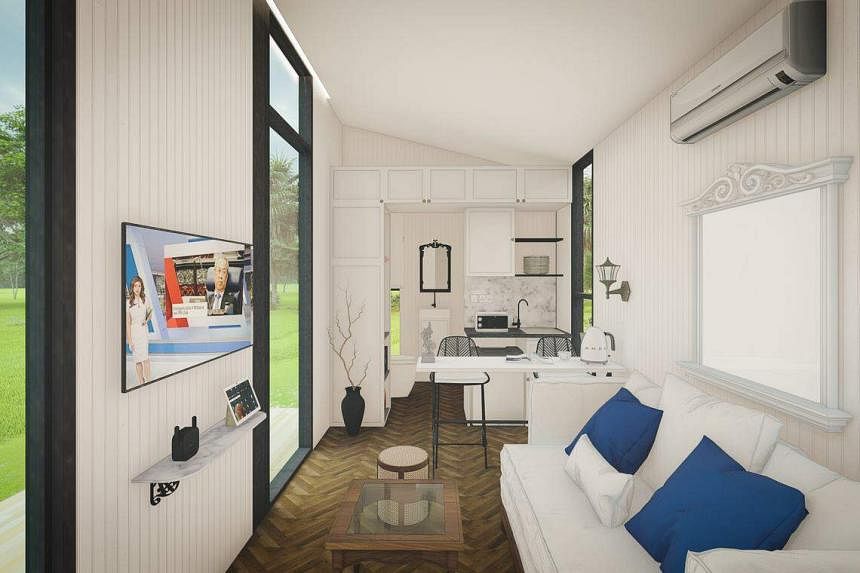SINGAPORE - Nature groups say Lazarus Island has the potential to become a role model for eco-tourism – as long as new developments planned for it continue to be led by guidelines for the protection and understanding of nature.
This will require developers to continue to closely collaborate with the nature community to minimise harm to the environment and also ensure activities planned for the island have an educational component.
These groups spoke to The Straits Times following the announcement at the Government’s Budget debate last week that five “tiny homes” will be available for bookings on the southern island from April. It will be the first time accommodation will be provided on the 47ha island.
Known as Tiny Away Escape @ Lazarus Island, each unit comes equipped with green features, and the homes are part of initiatives by Sentosa Development Corporation (SDC) to transform the island into a “light-touch” eco-tourism location.
Other new amenities and activities, such as a convenience store, overnight glamping and non-motorised water activities, will be launched in phases by around June.
Lazarus Island is a small island among Singapore’s Southern Islands known for its tranquil and beautiful beaches with clean white sand and clear waters. Day trippers frequent it as a recreational hot spot and its lagoon is often where recreational boaters stop to frolic in the water.
It currently has only basic public amenities like toilets, shelters, benches and rubbish bins.
It is connected to St John’s Island by a causeway, and there are daily ferries from Marina South Pier to St John’s Island between 9am and 6pm.
St John’s Island is also the site of several aquaculture and marine research facilities, like the St John’s Island National Marine Laboratory (SJINML) managed by the National University of Singapore, which has a gallery that the public can visit for free.
Ms Sam Shu Qin, co-founder of non-profit organisation Our Singapore Reefs, said: “As land gets more scarce, even locations like St John’s and Lazarus that once predominantly used to be for research need to become more multi-use... However, this new site can be a test to see if we can manage such development while taking care of the environment.”
She added: “If nature groups are able to work closely with developers to do that in a carefully calibrated way, this place could be a role model for eco-tourism, and can give the nature community confidence that development and conservation can co-exist in Singapore.”
While he welcomes less intrusive forms of lodging such as mini-homes and camping, Mr Stephen Beng, chairman of Friends of Marine Park, said other outreach and education efforts to strengthen a “conservation culture” in visitors are required.
He said programmes for the islands should all have an educational component teaching participants how to interact with nature in a thoughtful and positive way.
For instance, Friends of Marine Park conducts regular cleanups and intertidal walks on St John’s Island that also inform participants of the impact of pollution on coastal ecology. The group is in the midst of planning more nature-based activities at Bendera Bay.
Mr Beng said: “What we’re after is how to role-model responsible ways to protect nature through whatever activities we enjoy... The hope is that these activities can be a good ‘eco-class’ on how to have fun while also being mindful of the environment.”
He added: “Our hope is for visitors to take this conservation ethic we have at the Sisters’ Islands Marine Park to any natural destination that they visit.”

Sisters’ Islands Marine Park is a 40ha area that comprises the two Sisters’ Islands, the surrounding reefs and the western reefs of nearby St John’s Island and Pulau Tekukor. It is Singapore’s only marine park.
Dr Jani Tanzil, a senior research fellow and deputy facility director of SJINML, is grateful the SDC engaged stakeholders on the tiny-homes project for Lazarus Island, to reduce the impact of construction on the environment.
She added: “I hope, moving forward, they also take further into consideration the feedback from the community to firm up trash management plans, sewage – both from islandgoers and recreational yachters to the area – and safety management.”
Mr Beng noted that bins on the island are frequently full and people leave rubbish next to the bins, which can end up feeding the monkeys on the island.
Ms Sam said this may fuel human-wildlife conflict, and suggested more bins with lids be placed around the island and the cleaning frequency be stepped up to account for the potential influx of visitors.
She said these concerns were aired during engagement sessions with SDC, which said it would find operators to manage the problem appropriately, but more details have yet to be shared.

Ms Sam also highlighted some safety concerns, including strong currents and weather conditions that can affect how safe the waters are.
Even with these concerns in mind, Nature Society Singapore president Shawn Lum said the Southern Islands provide a rich opportunity for eco-tourism.
“The Lazarus Island experience can be enriching and enlightening – transformative even,” he said.
“I am sure many in the local nature and ecology community would be able to work with service providers to devise fun, creative, nature-positive activities for Lazarus Island visitors. The business people and tourism authorities behind this project need only reach out.”



